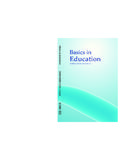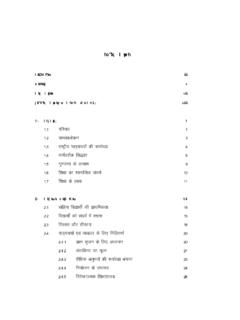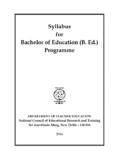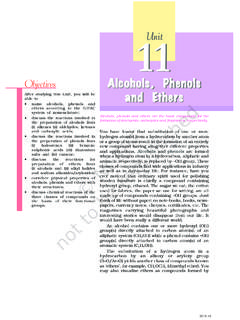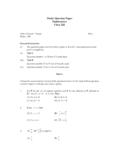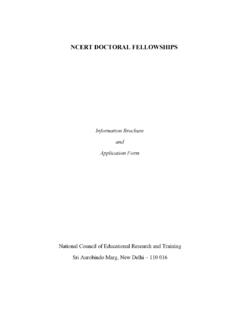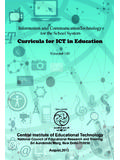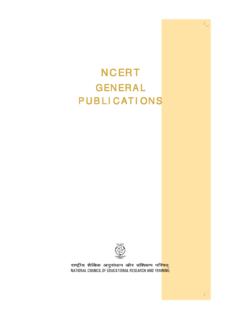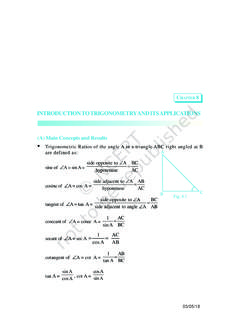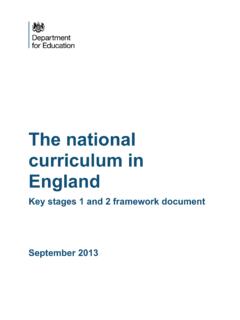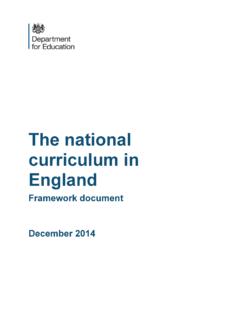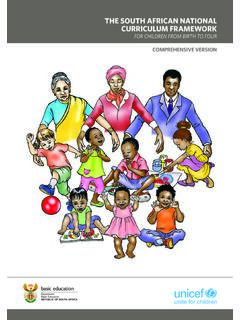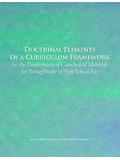Transcription of NATIONAL CURRICULUM FRAMEWORK 2005 - NCERT
1 NATIONAL CURRICULUMFRAMEWORK2005 FOREWORDI have had the privilege of participating in a remarkable process of social deliberationinitiated by NCERT to focus public attention on what should be taught to our children andhow. In the course of this wide-ranging churning of ideas and expectations, I have workedclosely with a large number of very special individuals for the preparation of the NationalCurriculum FRAMEWORK presented in this document. The names of these individuals aregiven in this is much analysis and a lot of advice. All this is accompanied by frequent remindersthat specificities matter, that the mother tongue is a critical conduit, that social, economicand ethnic backgrounds are important for enabling children to construct their ownknowledge. Media and educational technologies are recognised as significant, but the teacherremains central.
2 Diversities are emphasised but never viewed as problems. There is acontinuing recognition that societal learning is an asset and that the for mal CURRICULUM will begreatly enriched by integrating with that. There is a celebration of plurality and anunderstanding that within a broad FRAMEWORK plural approaches would lead to document frequently revolves around the question of CURRICULUM load on this reg ar d we seem to have fallen into a pit. We have bartered away understanding formemory-based, short-term infor mation accumulation. T his must be rev ersed, particularlynow that the mass of what could be memorised has begun to explode. We need to give ourchildren some taste of understanding, following which they would be able to learn andcreate their own versions of knowledge as they go out to meet the world of bits, imagesand transactions of life.
3 Such a taste would make the present of our children wholesome,creative and enjoyable; they would not be traumatised by the excessive burden of informationthat is required merely for a short time before the hurdle race we call examination. Thedocument suggests some ways of getting out of this self-imposed adversity. Achievingsome degree of success in this area would also signify that we have learnt to appreciate thecapacity for learning and the futility of filling up children s memory banks with informationthat is best kept as ink marks on paper or bits on a computer is not a physical thing that can be delivered through the post or through ateacher. Fer tile and robust education is alwa ys created, rooted in the physical and cultural soilof the child, and nourished through interaction with parents, teachers, fellow students andthe community.
4 The role and dignity of teachers in this function must be strengthened andunderlined. There is a mutuality to the genuine construction of knowledge. In thistransaction the teacher also learns if the child is not forced to remain passive. Since childrenusually perceive and observe more than gro wn-ups, their potential role as knowledgecreators needs to be appreciated. From personal experience I can say with assurance that alot of my limited understanding is due to my interaction with children. The document doesdwell on this rich and comprehensive nature of this document would not have been achievedwithout a special ignition that enveloped all those who got involved. I do not know whostruck the spark perhaps it was no one in particular. Perhaps the effort happened at apoint in time when a critical mass of discomfort had accumulated.
5 Enough is enough, wasthe feeling amongst most of the participants. Perhaps the enthusiasm of a few was tempting to assign blame for many things that have not gone as well as wewished many decades ago. We have tried to avoid playing the blame game perhaps due tothe fact that we are all responsible in one way or another. Most of us are responsible asmembers of a middle class that had begun to emotionally secede from the mass of peoplein the country. I was struck by the frequency of words like pluralism , equity and equality during our discussions. I do not believe that they are part of a political rhetoric, because wetalked ver y little politics in our extensive discussions. I believe this came about because wewere led to a conviction that our strength lies in the presently deprived three-fourths of ourpeople.
6 Marrying their socially acquired competences and skills with academic pursuits inour educational institutions would lead to a special flowering of talent and document suggests ways of moving in that direction. Some of the systemicchanges sugg ested would definitely help. I hope we can become operational on ideas of acommon school system, work and education, and letting children enter the world of for mallearning through the language of their home and do not feel daunted by the task. We feel it is doable. I hope this effor t might starta freedom movement for the education of our young away from some of the tyranniesin which we have enveloped PalivACKNOWLEDGEMENTSN ational CURRICULUM FRAMEWORK (NCF) 2005 owes its present shape and for m to theflurry of ideas generated through a series of intensive deliberations by eminent scholarsfrom different disciplines, principals, teachers and parents, representatives of NGOs, NCERT faculty, and several other stakeholders at various levels.
7 It received significant contributionsfrom state Secretaries of Education and Directors of SCERTs, and participants of there gional seminars organised at the RIEs. Experiences shared by principals of priva te schoolsand Kendriya Vidyalayas and by teachers of rural schools across the country helped insharpening our ideas. Voices of thousands of people students, parents, and public atlarge through regular mail and electronic media helped in mapping multiple document has benefited immensely from a generous flow of constructivesuggestions and perceptive comments from members of NCERT s own establishmentand its higher-level committees, Executive Committee, General Council and CentralAdvisory Board of Education. State governments were specifically requested to organiseworkshops to discuss the draft NCF during July-August 2005, and we are grateful for there ports received from several states and the Azim Premji Foundation which organised aseminar in collaboration with the governments of Madhya Pradesh, Rajasthan, etc.
8 Discussionswere also organised by Ker ala Sastra Sahithya Parishad (Trichur) and All India People sScience Networ k (Trichur), Bharat Gyan Vig yan Samiti (New Delhi), SIEMAT (Patna),The Concerned for Working Children, Bangalore, Trust for Educational Integ ratedDevelopment (Ranchi), Koshish Charitable Tr ust (Patna), and Digantar (Jaipur). T he Councilfor Indian School Certificate Examination (New Delhi), Central Board of SecondaryEducation (New Delhi), Boards of Secondary Education of States, Council of Boards ofSchool Education (COBSE) in India (New Delhi) actively helped us in the crystallizationof our ideas. Sincere acknowledgement for hosting meetings is due to the Academic StaffCollege of India, Hyderabad; Homi Bhabha Centre for Science Education, Mumbai;Jadavpur University, Kolkata; Ali Yavar Jung NATIONAL Institute of Hearing Handicapped,Mumbai; NATIONAL Institute of Mental Health, Secunderabad; Foundation, Secunderabad;Sewagram, Wardha; NATIONAL Institute of Public Cooperation and Child Development,Guwahati; State Council of Educational Research and Tr aining, T hiruv ananthapuram, CentralInstitute of English and Foreign Languages, Hyderabad, Central Institute of IndianLanguages, Mysore; NATIONAL Institute of Design, Ahmedabad; SMYM Samiti, Lonawala,Pune; North Eastern Hill Univer sity, Shillong; DSERT, Bangalore; IUCAA, Pune.
9 Centrefor Environment Education, Ahmedabad and Vijay Teachers College, has been translated into the languages of VIII Schedule of the thanks are due to Dr. D. Barkataki (Assamese), Shri Debashish Sengupta (Bangla),Dr. Anil Bodo (Bodo), Prof. Veena Gupta (Dogri), Shri Kashya p Mankodi (Gujarati),Ms. Pragathi Saxena and Mr. Prabhat Ranjan (Hindi), Shri S. S. Y adurajan, (Kannada), Dr. SomnathRaina (Kashmiri), Shri Damodar Ghanekar (Konkani), Dr. Neeta Jha (Maithili), Shri K. Kumar (Malayalam), Shri T. Surjit Singh Thokchom (Manipuri), Dr. Datta Desai(Marathi), Dr. Khagen Sarma (Nepali), Dr. Madan Mohan Pradhan (Oriya), Shri RanjitSingh Rangila (Punjabi), Shri Dutta Bhushan Polkan (Sanskrit), Shri Subodh Hansda (Santhali),Dr. Lekhwani (Sindhi), Mr A. V allinayagam (Tamil), Shri V Balasubhramanyam(Telugu) and Dr.
10 Nazir Hussain (Urdu). W e place on record our gra titude to Mr Raghavendra,Ms. Ritu, Dr. Apoorvanand, and Ms. Latika Gupta, Dr. Madhavi Kumar, Dr. ManjulaMathur and Ms. Indu Kumar for editing the Hindi text; and to Shri Harsh Sethi andMs. Malini Sood for a meticulous scrutiny of the manuscript and Shri Nasiruddin Khanand Dr. Sandhya Sahoo for reading parts of the manuscript and making helpful sugg also express our gra titude to Ms. Shweta Rao for the design and layout of the document,Mr. Robin Banerjee for photographs on the cover and page 78 andMr. Dass of CIET for other photographs, our colleagues in DCETA for providingsupport in dissemination of NCF through the NCERT website and the PublicationDepartment for bringing out the NCF in its present for m.
